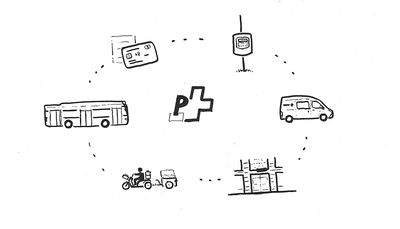AtlasSocial InfrastructureLazar Riva and Lelan Yung
There are general trends that point to density of population to density of resources. This starts to spin a cause-effect wheel, with the question of what comes first: the people or the infrastructure? In the digital world, people generally move to locations of better accessibility to technology, communication, and education, suggesting a people-follow-resources approach. But in the context of thinking about “Village Life”—where resources are comparably less accessible in rural areas than in urban centres—what circumstances could influence people to move before such infrastructure takes place?
Social infrastructure is deeply intertwined with people. Higher concentrations of human population correlate to more resources for systems that people use to facilitate daily needs for education and communication. However, the spread of these resources amongst communes within the Canton of Zurich is not completely straightforward and can instead be categorised into infrastructures that are centralised, decentralised, or a mix of the two. In terms of accessibility for equitable resource distribution, the decentralisation of social infrastructures is arguably preferable for the future.
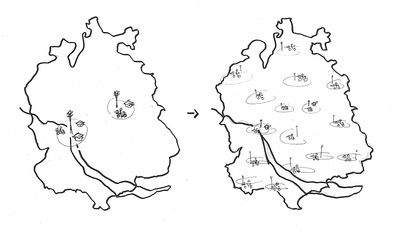
Ubiquitous Network Coverage
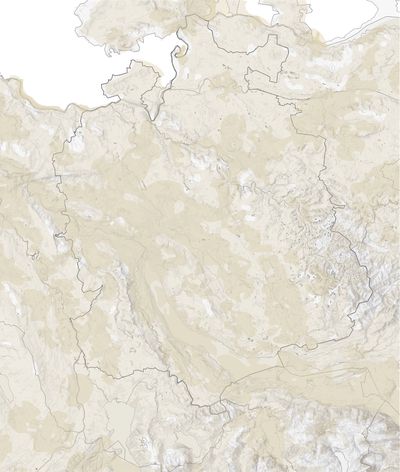
Cell phone network coverage. Source: Swisscom.
- 4G
- 5G
Today, Swiss cellular networks are widespread and readily available. Although 5G service is currently not as ubiquitous, 4G coverage reaches almost the entirety of the Canton of Zurich. The newer 5G is relatively centralised in regions of higher population, particularly the city of Zurich, Winterthur, and along the Limmat. However, the existing 4G network represents a decentralised system, where the infrastructure is not in a specific location but rather accessible to almost all residents in the canton. In current times, a cellular network is essential as a means for digital connectivity.

Because of time, 4G has become available for almost all of the canton. However, 5G masts offer a unique advantage in that the points of service are smaller and more dense than their 4G counterparts. In the future, this could mean an easier method of 5G installation in rural areas, without having to construct large cell towers.
Food Delivery in the Periphery

The ability to order food can be a byproduct of having network coverage. In 2022, every commune in the Canton of Zurich has access to at least seven delivery options from at least one food delivery service provider. These services are not only beneficial to residents in the cantons, but also to the restaurants who offer takeaway options. Before delivery services, restaurants had centralised range, only able to serve those who could come to the store. Now, with online order and delivery, a restaurant’s range has increased dramatically and is becoming less centralised.


Number of delivery options from Just Eat Takeaway service. Source: Just Eat.
- 7-50
- 51-100
- 101-150
- 151-200
- 201+
Every commune in the Canton of Zurich has access to restaurants from the Just Eat food delivery service.
Vanishing Post Offices
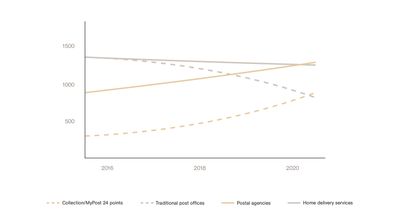
Switzerland’s postal system offers both centralised and decentralised infrastructure. However, what is deemed centralised now was not always the case in the past. In 2016, the number of postal branch locations (traditional post offices) far exceeded the number of letterbox (collection) points. Five years later, a number of branches have been shut and letterbox points have increased around the canton, resulting in a recent overtaking of traditional post office quantities by collection/myPost24 quantities. When sending post, people generally require the smaller letterboxes, making its decentralisation useful for most situations. However, decreasing the number of branches has left some communes without a branch. Residents of these communes now have to travel farther to a centralised postal branch to complete certain transactions such as paying bills or sending large parcels.
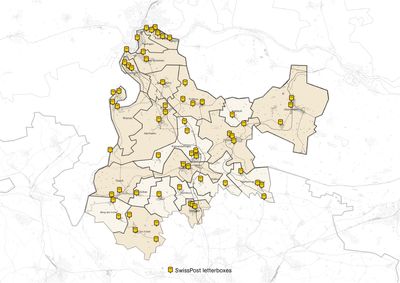
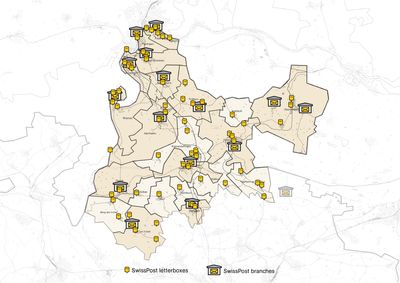
Education Stays in the City

The availability of schools becomes more centralised as the level of education increases. This trend can be seen when looking at school districts such as Winterthur. However, there are still disparities when it comes to rural and remote areas, some of which even lack kitas, the lowest level of education/child care. This can be thought of in a cycle of accessibility to infrastructure, wealth, and education. Without one, it is generally more difficult to have another.
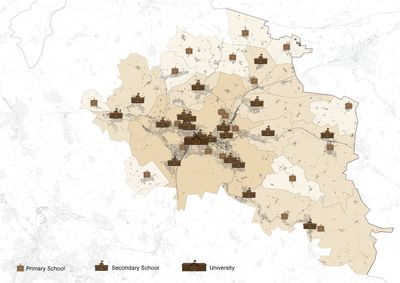
Education typologies in Winterthur. Source: Kanton Zurich.

Percentage of persons with a matura diploma.
- 6%-16%
- 16%-26%
- 26%-36%
- 36%-47%
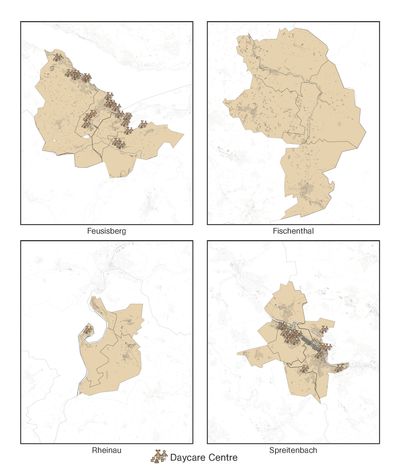
Kita locations in four communes.
It is in this sector where decentralisation can have major effects for the community, especially in village life. If kitas can become more accessible in rural areas such as Fischenthal and Rheinau, it may give more incentive for people and families to live in these regions. Temporary education structures and remote learning have already started to reshape and rethink the accessibility questions of education, from kitas all the way to universities. In this way, both physical and digital means are contributing to a potential start in the decentralisation of schooling.

